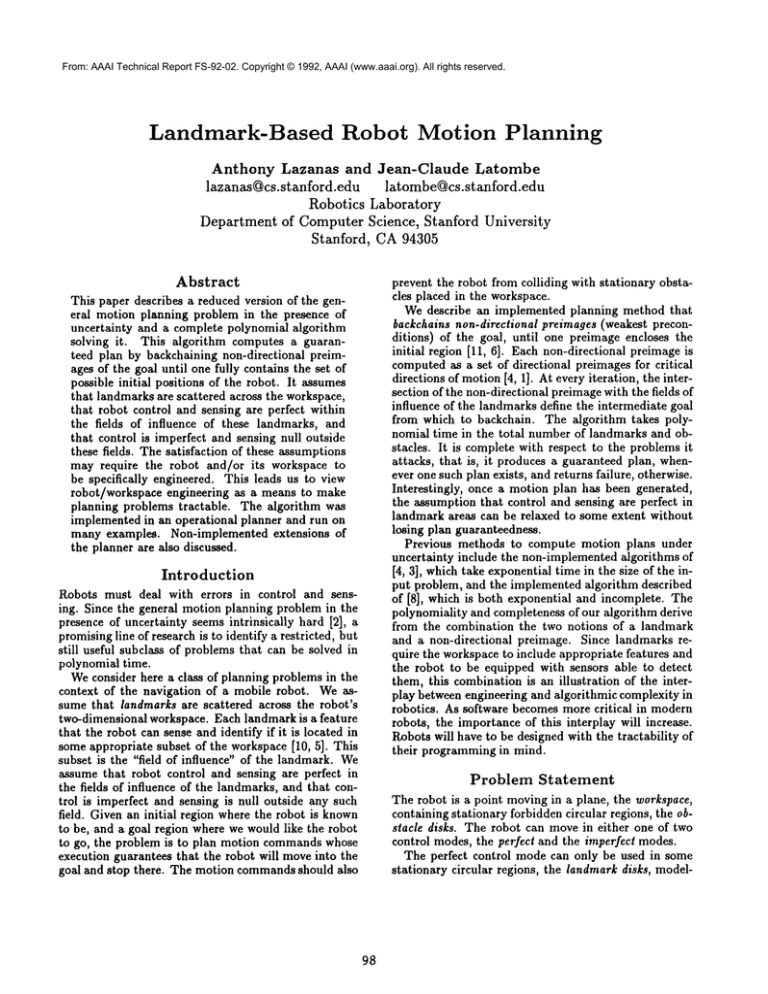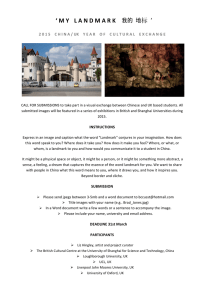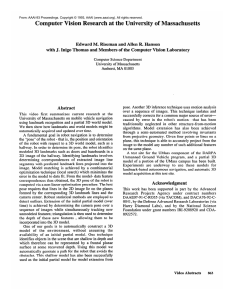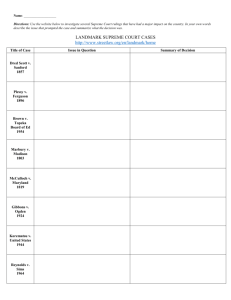
From: AAAI Technical Report FS-92-02. Copyright © 1992, AAAI (www.aaai.org). All rights reserved.
Landmark-Based
Robot Motion
Planning
Anthony
Lazanas
and Jean-Claude
Latombe
lazanas@cs.st
anford.edu
latombe@cs.st
anford.edu
Robotics Laboratory
Department of Computer Science,
Stanford University
Stanford,
CA 94305
Abstract
This paper describes a reduced version of the general motion planning problem in the presence of
uncertainty and a complete polynomial algorithm
solving it. This algorithm computes a guaranteed plan by backchaining non-directional preimages of the goal until one fully contains the set of
possible initial positions of the robot. It assumes
that landmarks are scattered across the workspace,
that robot control and sensing are perfect within
the fields of influence of these landmarks, and
that control is imperfect and sensing null outside
these fields. The satisfaction of these assumptions
may require the robot and/or its workspace to
be specifically engineered. This leads us to view
robot/workspace engineering as a means to make
planning problems tractable.
The algorithm was
implemented in an operational planner and run on
many examples. Non-implemented extensions of
the planner are also discussed.
Introduction
Robots must deal with errors in control and sensing. Since the general motion planning problem in the
presence of uncertainty seems intrinsically hard [2], a
promisingline of research is to identify a restricted, but
still useful subclass of problems that can be solved in
polynomial time.
Weconsider here a class of planning problems in the
context of the navigation of a mobile robot. Weassume that landmarks are scattered across the robot’s
two-dimensional workspace. Each landmark is a feature
that the robot can sense and identify if it is located in
some appropriate subset of the workspace [10, 5]. This
subset is the "field of influence" of the landmark. We
assume that robot control and sensing are perfect in
the fields of influence of the landmarks, and that control is imperfect and sensing is null outside any such
field. Given an initial region where the robot is known
to be, and a goal region where we would like the robot
to go, the problem is to plan motion commandswhose
execution guarantees that the robot will moveinto the
goal and stop there. The motion commandsshould also
98
prevent the robot from colliding with stationary obstacles placed in the workspace.
We describe an implemented planning method that
backchains non-directional preimages (weakest preconditions) of the goal, until one preimage encloses the
initial region [11, 6]. Each non-directional preimage is
computed as a set of directional preimages for critical
directions of motion[4, 1]. At every iteration, the intersection of the non-directional preimagewith the fields of
influence of the landmarks define the intermediate goal
from which to backchain. The algorithm takes polynomial time in the total number of landmarks and obstacles. It is complete with respect to the problems it
attacks, that is, it produces a guaranteed plan, whenever one such plan exists, and returns failure, otherwise.
Interestingly, once a motion plan has been generated,
the assumption that control and sensing are perfect in
landmark areas can be relaxed to some extent without
losing plan guaranteedness.
Previous methods to compute motion plans under
uncertainty include the non-implemented algorithms of
[4, 3], which take exponential time in the size of the input problem, and the implemented algorithm described
of [8], which is both exponential and incomplete. The
polynomiality and completeness of our algorithm derive
from the combination the two notions of a landmark
and a non-directional preimage. Since landmarks require the workspace to include appropriate features and
the robot to be equipped with sensors able to detect
them, this combination is an illustration of the interplay between engineering and algorithmic complexity in
robotics. As software becomes more critical in modern
robots, the importance of this interplay will increase.
Robots will have to be designed with the tractability of
their programming in mind.
Problem
Statement
The robot is a point moving in a plane, the workspace,
containing stationary forbidden circular regions, the obstacle disks. The robot can movein either one of two
control modes, the perfect and the imperfect modes.
The perfect control mode can only be used in some
stationary circular regions, the landmark disks, model-
From: AAAI Technical Report FS-92-02. Copyright © 1992, AAAI (www.aaai.org). All rights reserved.
F
E
D
B
@
@
Figure 1: Example of a planning problem
ing the fields of influence of the landmarks. These disks
have null intersection with the obstacle disks. Whenthe
robot is in a landmarkdisk, it knowsits position exactly
and it has perfect control over its motions. Somedisks
mayintersect each other, creating larger areas, called
landmark areas, through which the robot can move in
the perfect control mode. A motion commandin the
perfect control mode is called a P-command.
A motion commandin the imperfect control mode,
called an 1-command, is described by a pair (d,£),
where d E S1 is a direction in the plane (the commandeddirection) and £ is a set of landmark disks (the
termination set). This commandcan be executed from
anywhere in the plane outside the obstacle disks. The
robot follows a path whose tangent at any point makes
an angle with the direction d that is no greater than
some prespecified angle 0 (the directional uncertainty).
The robot stops as soon as it enters a landmark disk in
£.
The robot has no sense of time, which means that
the modulusof its velocity is irrelevant to the planning
problem.
At planning time, the initial position of the robot is
knownto be anywherein a specified initial region I that
consists of one or several disks. Eachinitial-region disk
maybe disjoint from the landmark areas, or it mayoverlap someof them, or it maybe entirely contained in one
99
of them. The robot must move into a given goal region
C0, which is any subset of the workspace whose intersection with the landmark disks is easily computable.
The problem is to generate a guaranteed motion plan,
i.e., an algorithm made up of I- and P-commandswhose
execution guarantees that the robot will be in Go when
the execution of the plan terminates. The robot is not
allowed to collide with any of the obstacle disks.
This problem is a simplification of a real mobile-robot
navigation problem, but it captures its most important
aspects [9].
In the sequel we assume that there are ~ disks (landmarks and obstacles) in total.
Example
Fig. 1 illustrates the previous statement with an example run using the implemented planner. The workspace
contains 23 landmark disks (shown white or grey) forming 19 landmark areas, and 25 obstacle disks (shown
black). The directional uncertainty 0 is set to 0.09 radian. The initial and goal regions are two small disks
designated by I and C0, respectively. The white landmark disks are those with which the planner has associated I-commands. The arrow attached to a white disk
is the commandeddirection of motion of an I-command
planned to attain another set of disks. There is at least
one arrow per white landmark area not intersecting the
From: AAAI Technical Report FS-92-02. Copyright © 1992, AAAI (www.aaai.org). All rights reserved.
goal.
share the same endpoint,
Execution begins with performing the I-commandattached to 2". Whenthe robot reaches a landmark disk in
the termination set of this command,it is guaranteed
that a P-commandis attached to this disk to attain
a point in the current landmark area that is either a
goal point (if the goal region intersects this landmark
area) or such that an I-commandis associated with it
(the arrows shown in the figure are drawn from such
points). In the first case, plan execution terminates
whenthe goal point is attained. In the second case, the
I-commandis executed, and so on.
The figure also shows the path produced by a sample
execution of the plan. This path first takes the robot
from the initial region to the landmark area designated
by B. From there, it successively attains and traverses
the landmark areas marked C, D, E, F, G, H, J, K,
M, and N. The P-command associated with N takes
the robot to {70 where it stops. Due to control errors,
other executions of the same plan could produce other
paths traversing different landmark disks.
they form a spike.
Lemma1 The boundary of a directionai preimage has
size O(t). It is computed in O(glogt) time and O(t)
space.
Directional
Preimage
Consider a goal region {7. Wedefine the kernel of {7 as
the largest set of landmarkdisks such that, if the robot
is in one of them, it can attain the goal by executing
a single P-command. Thus, the kernel of {7, denoted
by K({7), is the set of all the landmark areas having
a non-zero intersection with {7. The disks in K({7) are
called the kernel disks. The other landmark disks are
called the non-kernel disks.
The directional preimage of {7, for any given commandeddirection of motion d, is the region P({~, d) defined as the largest subset of the workspacesuch that, if
the robot executes the I-command(d, K({7)) from
position in P({7, d), then it is guaranteed to reach K({7)
and thus to stop in K({7). From the entry point
the kernel, the robot can attain {7 by executing a Pcommand.
Fig. 2 shows an example of a directional preimage:
the black disks are obstacles; all other disks are kernel
landmark disks; the preimage is striped. P({7, d) consists of one or several connected subsets bounded by
circular segments (arcs) and straight segments (edges).
Each arc is a subset of the boundary of a kernel disk
or an obstacle. Let the left ray (resp. right ray) of a
kernel disk L be the half-line tangent to L erected from
the tangency point in the direction pointed by ~+d+O
(resp. 7r+d-0), with L on its right-hand side (resp. lefthand side). The right ray (resp. left ray) of an obstacle
disk is defined in the same way, but with orientation
x+d+0 (resp. It+d-O), with the obstacle on its righthand side (resp. left-hand side). Each edge of P({7,
is contained in the right or left ray of somekernel disk
or obstacle disk. One extremity of the edge is the tangency point of the ray; the other extremity is the first
intersection point of the ray with another kernel disk,
an obstacle disk, or another erected ray. If two edges
100
Non-Directional
Preimage
Consider the directional preimage P({7, d) whend varies
continuously over S1. The topology of the preimage
and/or the topology of its intersection with the initialregion disks and the non-kernel landmark disks change
at a finite number of critical directions corresponding
to events caused by the motion of an edge or a spike
of the preimage relative to the kernel landmark disks,
the obstacle disks, the initial-region disks, and the nonkernel landmark disks. Wecall the critical directions
where the topology of the directional preimage does
change the D-critical directions and those where the
topology of the intersection of the directional preimage
with the initial-region disks (resp. the non-kernel landmark disks) changes, other than the D-critical directions, the I-critical (resp. L-critical) directions. Fig. 3
illustrates
the D-critical directions caused by kernel
landmark disks. See [9] for a description of the other
critical directions. Weassume that the various disks
are in general position, i.e., no two events occur simultaneously.
Lemma2 There are 0(~3) D-critical directions, 2)
O(g
I-critical directions, and O(g3) 1L-critical directions.
Let (d~t,...,dc,)
be the cyclic list of all critical directions in counterclockwise order and I1,..., Ip
be the regular intervals
between them, with Ii =
(de~,dc..~.
d
")"
For
any
interval
Ii, let dnel be any
s-l- ~mop)
direction m Ii. In order to characterize all the directional preimages of {7 and their intersection with Z and
the non-kernel disks, it suffices to computeP({7, d) for
all d E {d,,~,, d~x, d,¢2,..., dr,}. The set NP({7) of all
these directional preimages is called the non.directional
preimageof {7 [4].
To compute the non-directional
preimage we first
construct the directional preimage of {7 for an arbitrary direction d~ E S1. The rest of the computation is
an alternation of event scheduling and event processing
phases.
Lemma 3 The computation of the non-directional
preimage takes O(g3 logt) time and 0(~3) space.
Planning
Method
If the initial region Z is not contained in the goal region {70, the planner first computes the kernel K({70).
If K({70) = 0, the planner returns failure. Otherwise,
it associates a P-commandto reach a goal point with
every landmark disk in this kernel. If 2- C K({70) the
planner returns success.
1Weconjecture, however,that there are only O(t2) critical directions in total.
From: AAAI Technical Report FS-92-02. Copyright © 1992, AAAI (www.aaai.org). All rights reserved.
Figure 2: A directional
Assume that 2;¢ K(G0). The planner then computes
the non-directional preimage NP(Go). If NP(Go) contains a directional preimage P(90, d) that includes
then the planner attaches the I-command (d,K(~0))
to 2" and returns success. Otherwise, for every landmark area LA ¢ K(~o) that has a non-zero intersection with a directional preimage P(g0, d) in NP(g0),
"exit point" is arbitrarily selected in LA N P(9o, d) and
the I-command(d, K(g0)) is attached to this point.
the same area LAintersects several directional preimages, only one intersection is used to produce the Icommand.)
The union of the directional
preimages in NP(Go)
is now recursively considered as a goal {~1. Its kernel K(~I) is constructed. By construction, K({~I)
K({~0). If K(~I) = K({~0), the planner terminates
failure since it cannot computea larger non-directional
preimage than NP({~0). Otherwise, every landmark
area in K(~I)\K(G0) contains one disk L with an
point and an I-command attached to it. With every
other disk in the landmark area, the planner associates
a P-commandto reach the exit point in L. IfZC K({~I)
the planner returns success, else it computes the nondirectional preimage of ~1, and so on.
During this baekchaining process, the set of landmark
areas in the kernels of the successive goals increases
monotonically. At every iteration, either there is a new
landmark area in the kernel, and the planner proceeds
further, or there is no new area, and the planner terminates with failure. The planner terminates with success
whenever it has constructed a kernel K({~n) containing
2" or a non-directional preimage NP(~n) that includes
directional preimage containing I. Let s be the number
of landmark areas. The number of iterations is bounded
by s. Thus, n _< s.
Theorem 1 The planning algorithm
is complete and
101
preimage
generates optimal guaranteed plans. ~ It takes O(s£3 +
~31oU)
timeando(~3) space.
The computed plan is represented as an unordered set
of motion commandsdistributed over the initial-region
disks and landmarkdisks (see Fig. 1). This kind of representation is reminiscent of the concept of a "reaction
plan" introduced in classical AI planning research [12].
If the input problem admits no guaranteed plans, the
planner nevertheless constructs such a plan, but with no
motion commandattached to the initial-region
disks.
Then the robot can try to enter one of the landmark
areas where a commandis available, by performing an
initial randommotion with reflection on the obstacles’
boundary. If an unexpected event occurs at execution
time, the robot may attempt to reconnect to the plan
in the same way.
Experimental Results
The above planning method is implemented in C on a
DECstation 5000, along with a robot simulator. We
experimented with it on many examples. The example
shownin Fig. 1 is one of them. It required the computation of 12 successive non-directional preimages and
took about 3.5 minutes of computation time. See [9]
for more experimental examples.
Discussion and Extensions
These are non-implemented extensions of the planner:
- Uncertainty in landmark areas: Perhaps the less realistic assumption in the problem statement of Section
2 is that control and sensing are perfect in landmark
areas. However, this assumption can be partially eliminated. Indeed, a landmark area is included in a kernel
2Herea plan is said to be optirnalif the ma~ximalnumber
of executed motion commandsis minimal over all possible
guaranteed plans.
From: AAAI Technical Report FS-92-02. Copyright © 1992, AAAI (www.aaai.org). All rights reserved.
!t
(a) Left Touch
Co)LeftBirth
(c) Left Exit
(d) Left Vertex (e) Spike
(0 Right Touch
(g) Right Death
(h) Right Exit
(i) Right Vertex (j) Hidden Spike
Figure 3: SomeD-critical directions
if it has a non-zero intersection with the goal or a previously computed directional preimage. At execution
time, if the robot enters this area, it must only be guaranteed that it can moveinto this non-zero intersection
before it executes the next step in the plan. This does
not require perfect sensing or control.
- Landmarkand obstacle geometry: In our current implemention, the landmark and obstacle areas must be
unions of circular disks. But the algorithm can be easily adapted to deal with areas described as generalized
polygons bounded by straight and circular edges. It can
also accept landmark and obstacles areas that touch
each other. The degree of any curve traced by a spike
remains no greater than 4. If the workspace contains
s landmark areas bounded by O(t) edges and arcs and
the obstacle areas are bounded by O(g) edges and arcs,
the time complexity of the planner is O(sl3 + ga logl).
Representing landmark and obstacle areas as generalized polygons is a very realistic model for most applications.
- Compliant motions: The planning algorithm can be
extended to allow compliant motion commandsmaking
the robot slide in obstacle boundaries [11]. This extension would enlarge the set of problems admitting
guaranteed plans. In general, it would also allow the
planner to produce shorter motion plans.
- Varying directional uncertainty: Let Pe(~, d) denote
the directional preimage of 9 for the direction d computed with the directional uncertainty 0. Let us say
that a value 0c of the directional uncertainty is critical if there exists d E S1 such that the intersections
of Ps,+, (~, d) and Pet-, (~i, d), for an arbitrarily small
e, with the initial-region and the non-kernel disks are
102
topologically different. The algebraic equations defining O~ can be established by tracking the variations
of the non-directional preimage contour when 0 varies.
The values of 8~ can be exploited to adapt the directional uncertainty used by the planner to the failures
and successes met while executing previous plans.
Conclusion
We described a complete polynomial planning algorithm for mobile-robot navigation in the presence of
uncertainty. The algorithm solves a class of problems
where landmarks are scattered across the workspace.
With the possible exception of [7], previous algorithms
to plan motion strategies under uncertainty were either
exponential in the size of the input problem, or incomplete, or both. Our work shows that it is possible to
identify a restricted, but still realistic, subclass of planning problems that can be solved in polynomial time.
This subclass is obtained through assumptions whose
satisfaction mayrequire prior engineering of the robot
and/or its workspace. In our case, this implies the creation of adequate landmarks, by taking advantage of
the natural features of the workspace, or introducing
artificial beacons, or using specific sensors. This work
gives a formal justification
to robot/workspace engineering: make planning problems tractable. Engineering the robot and the workspace has its own cost and
we would like to minimize it. Our future research will
address this issue.
Acknowledgments: This research has been partially
funded by DARPAcontract DAAA21-89-C0002
and ONRcontract N00014-92-J-1809.
From: AAAI Technical Report FS-92-02. Copyright © 1992, AAAI (www.aaai.org). All rights reserved.
References
[1] Briggs, A.J., "An efficient Algorithm for One-Step
Planar Compliant Motion Planning with Uncertainty," Proc. of the 5th Annual ACMSyrup. on
Computational Geometry, Saarbruchen, Germany,
1989, pp. 187-196.
[2] Canny, J.F. and Reif, J., "NewLower Bound Techniques for Robot Motion Planning Problems," 27th
IEEE Symposium on Foundations of Computer
Science, Los Angeles, CA, 1987, pp. 49-60.
[3] Canny, J.F., "On Computability of Fine Motion
Plans," Proc. of the IEEE Int. Conf. on Robotics
and Automation, Scottsdale, AZ, 1989, pp. 177182.
[4] Donald, B.R., ’~I’he Complexity of Planar Compliant Motion Planning Under Uncertainty," Aigorithmica, 5, 1990, pp. 353-382.
[5] Donald, B.R. and Jennings, J., "Sensor Interpretation and Task-Directed Planning Using Perceptual Equivalence Classes," Proc. of the IEEE
Int. Conf. on Robotics and Automation, Sacramento, CA, 1991, pp. 190-197.
[6] Erdmann, M., On Motion Planning with Uncertainty, Tech. Rep. 810, AI Lab., MIT, Cambridge,
MA, 1984.
[7] Friedman, J., Computational Aspects of Compliant Motion Planning, Ph.D. Dissertation, Report
No. STAN-CS-91-1368, Dept. of Computer Science, Stanford University, Stanford, CA, 1991.
[8] Latomhe, J.C., Lazanas, A., and Shekhar, S.,
"Robot Motion Planning with Uncertainty in Control and Sensing," Artificial Intelligence J., 52(1),
1991, pp. 1-47.
[9] Lazanas, A., and Latombe, J.C., Landmark-Based
Robot Navigation, Tech. Rep. STAN-CS-92-1428,
Dept. of Computer Science, Stanford, CA, 1992.
[10] Levitt, T.S., Lawton, D.T., Chelberg, D.M. and
Nelson, P.C., "Qualitative Navigation," Image Understanding Workshop, Los Angeles, CA, 1987,
pp. 447-465.
[11] Lozano-P~rez, T., Mason, M.T. and Taylor, R.H.,
"Automatic Synthesis of Fine-Motion Strategies
for Robots," Int. J. of Robotics Research, 3(1),
1984, pp. 3-24.
Schoppers,
M.J., Representation and Automatic
[12]
Synthesis of Reaction Plans, Ph.D. Dissertation,
Dept. of ComputerScience, University of Illinois
at Urbana-Champaign, Urbana, IL, 1989.
103






